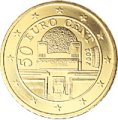Vienna Secession Building
The exhibition building of the Vienna Secession , colloquially known as the Secession , was built by Joseph Maria Olbrich in 1897/98 as an exhibition building for contemporary art, and it is still used today. It is one of the most important buildings of the Austrian Secession style ( Art Nouveau ).
history
“Walls should be, white and shiny, holy and chaste. Serious dignity should be woven around everything. Pure dignity, as it crept into me and shuddered when I stood lonely in Segesta in front of the unfinished sanctuary ... I only wanted to hear my own feelings in the sound, to see my warm feelings frozen in cold walls. "
Most of the costs for the building were borne by the members of the Secession artists' association, and the City of Vienna provided the building site free of charge. Allegedly this solution was found after a personal interview by Josef Engelhart with Mayor Karl Lueger after the construction of the exhibition house on the Ringstrasse had failed. For the city, the construction of the building was related to the regulation of the Wien River and the redesign of Karlsplatz , which, however, remained piecemeal. For example, an avenue was planned between the Karlskirche and the Secession building.
Formally, the building accommodates the Karlskirche reference, for its golden dome (a foliage gilded bronze ), by Eduard Pötzl the "vernacular" Krauthappel (= head of cabbage) called. Due to its large smooth walls and the cubic appearance, the building was also scolded as an Assyrian public institution.
Below the dome, the Secession's motto is emblazoned in gold letters: Time is its art, art is its freedom (by Ludwig Hevesi ). To the left of the entrance door there is a second motto: Ver Sacrum (Holy Spring), which is supposed to express the hope for a new art bloom and was the title of the association's own art magazine.
The building rests on eight meter high concrete pillars that reach down to the Wien River , which flows underground at this point .
Gustav Klimt's Beethoven frieze , originally created in 1902 for a temporary exhibition in the Vienna Secession, is now on permanent loan from the Belvedere and can be viewed in the basement.
A representation of the Secession building can be found on the reverse of the Austrian 50 cent coin .
Design elements
Gustav Klimt's brother Georg designed the bronze entrance doors. The two mosaic bowls next to the staircase leading to the entrance portal are by Robert Oerley . Identical bowls can be found at Villa Wustl. The six owls on the two side facades were designed by Koloman Moser . His round of wreath-bearers at the rear was stopped at an unknown time. The design of the gorgons above the entrance door was done by Othmar Schimkowitz .
To the right of the building is the bronze statue of Marc Anton by Arthur Strasser , which was originally created for the Paris World Exhibition in 1900 . The statue is popularly referred to as "Löwenfiaker".
Renovations
In 1985/86 a renovation took place under the direction of Adolf Krischanitz while the exhibition was still open.
From August 2017 to September 2018, again under Krischanitz's management and with ongoing operations, the facade including the dome was completely renovated. In addition, floors and air conditioning systems were renewed, access to the Beethoven frieze in the basement was made barrier-free by installing an elevator, the shop was redesigned and a separate event room was created. The chopped off wreath carriers by Koloman Moser at the rear of the building have been reconstructed. The cost of the renovation and modernization work amounted to 3.5 million euros. 1.2 million of these were taken over by the City of Vienna and the Federal Chancellery of the Republic, the remaining almost third was provided by the Secession and its sponsors and supporters.
Picture gallery
Arthur Strasser : Marc Anton Group (1899/1900)
Web links
Individual evidence
- ^ Gabriele Fahr-Becker: Art Nouveau. Quoted Egon Friedell: Anniversary volume for the 25th anniversary of WW Vienna 1928.
- ↑ Hermann Bahr explicitly names Pötzl as the actual inventor of the expression: HB: Love of the Living. Diaries 1921/23. Hildesheim: Borgmeyer 1925, II, 302.
- ^ Architecture in Vienna 1850 to 1930: Historicism, Art Nouveau, Objectivity
- ^ Beppo Beyerl : The Naschmarkt. Edition MoKKa, Vienna 2009, p. 186
- ↑ Secession refurbished and modernized on ORF Vienna on September 5, 2018, accessed on September 5, 2018.
Coordinates: 48 ° 12 ′ 1.3 ″ N , 16 ° 21 ′ 55.8 ″ E










